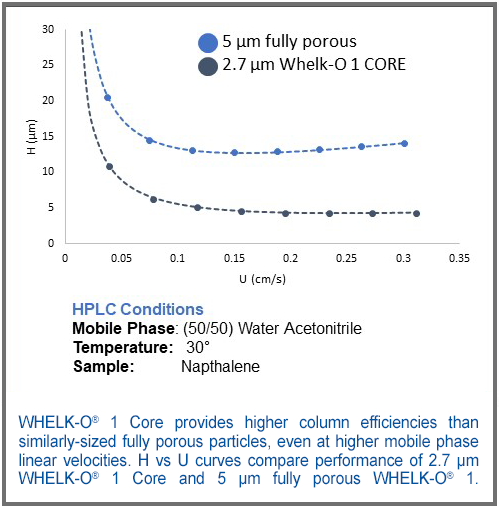Whelk-O®1
- Home
- Regis
- Chiral Columns for HPLC and SFC
- Whelk-O®1
The Whelk-O 1 Chiral Stationary Phase is based on 1-(3,5-Dinitrobenzamido)- 1,2,3,4,-tetrahydrophenanthrene. This phase allows separation of racemates from a number of families including amides, epoxides, esters, ureas, carbamates, ethers, aziridines, phosphonates, aldehydes, ketones, carboxylic acids, and alcohols.
- Excellent method development column with applicability to a wide range of compound classes
- Alternate selectivity to polysaccharide chiral stationary phases
- Covalently bonded for long term performance and broad mobile phase compatibility
- Broad range of particle sizes and dimensions for analytical to preparative scale separations
- High loading capacity for excellent scalability in preparative applications
- Choice of enantiomeric phases allows inversion of peak elution order
- Recognized as USP L102
Whelk-O1 Selector Structure

The Whelk-O 1 was originally designed for the separation of underivatized non-steroidal anti-inflammatory drugs (NSAIDs). This π-electron acceptor/π- electron donor phase allows broad selectivity, allowing resolution of a wide variety of underivatized racemates. The broad versatility observed with the Whelk-O 1 column, compares favorably with polysaccharide-derived chiral stationary phases and in many cases offers alternate selectivity. In addition, because of its covalent nature, this chiral phase is compatible with all commonly used mobile phases, including aqueous systems—a distinct advantage over coated polysaccharide chiral stationary phases. Other advantages include column durability, excellent efficiency, elution order inversion, and excellent loading capacity. Whelk-O 1 is available in a full range of particle sizes (1.8-, 3.5-, 5-, 10-, 16-, and 20 μm) to serve small scale analytical separations up to large scale preparative work.
Inversion of elution order on (R,R) and (S,S) Whelk-O 1
Whelk-O 1 columns are available in both R,R and S,S configurations. Choosing one or the other allows for peak elution order to be inverted. This can be beneficial in preparative and process scale applications when needing to elute one peak of interest quickly.

.jpg)
Whelk-O® 1 Core Chiral Columns
Whelk-O 1 Core chiral stationary phase is bonded to 2.7 µm core-shell particles for faster, highly efficient separations without increasing system back-pressure. Rapid screening of chiral samples can be performed in a fraction of the time, improving throughput by greater than 3X.

What is Core-shell Technology?
Core-shell particles have a solid silica core, enveloped by a homogenous porous shell. This reduces band broadening and improves efficiency, largely due to more rapid analyte mass transfer - from the mobile phase through the stationary phase and back again. This is because diffusion only occurs in the porous, outer layer of the particle, rather than the entire particle. The result is reduced analysis times and higher column efficiencies without generating extreme back-pressures.
Want to learn more about Whelk-O 1 Core? Download these informative resources.




